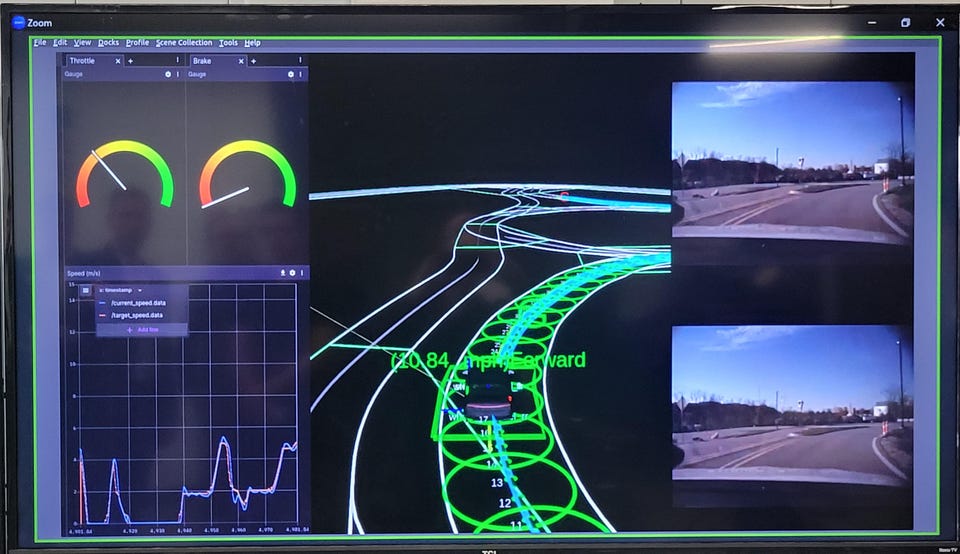Transportation Remote AV Testing Made Possible By $5. 1 Million Investment In Univ. Of Michigan Site Ed Garsten Senior Contributor Opinions expressed by Forbes Contributors are their own.
Following New! Follow this author to stay notified about their latest stories. Got it! Oct 24, 2022, 02:40pm EDT | New! Click on the conversation bubble to join the conversation Got it! Share to Facebook Share to Twitter Share to Linkedin Screen capture of live monitoring of autonomous vehicle test on the track at Mcity, the AV test . .
. [+] facility located at the University of Michigan. A $5.
1 million investment by the National Science Foundation to create Mcity 2. 0 allows researchers from around the U. S.
to create virtual AV testing scenarios. Ed Garsten As an autnomous car weaves its way around a test track, navigating a roundabout, avoiding other vehicles and a simulated child, researchers in remote locations are monitoring the test scenarios they created using virtual reality and other technologies. That demonstration Monday at Mcity , on the University of Michigan campus in Ann Arbor, Mich.
, was made possible by a $5. 1 million investment by the National Science Foundation (NSF) in the world’s first purpose-built test facility for connected and autonomous vehicles to create Mcity 2. 0.
Robert Stone, Division Director, Civil, Mechanical and Manufacturing Innovation Division, National . . .
[+] Science Foundation at an event October 24, 2022 marking the NSF’s $5. 1 million investment in the University of Michigan’s Mcity autonomous vehicle testing facility, Ann Arbor, Mich. Ed Garsten “This investment will support the world’s first cloud-based augmented reality test bed for connected and automated vehicle technologies and this test bed will be avaialble for use by academic researchers and students nationwide,” said Robert Stone, Division Director, Civil, Mechanical and Manufacturing Innovation Division at the National Science Foundation during a ceremony at Mcity.
“The new facility will accelerate the collaborative development of new vehicle technologies involving communication, sensing control, human dimensions. It will also provide easier and broader access to top tier research infrastructure through the cloud. ” MORE FOR YOU Hiring Refugees: How One Big Factory Did It New Psychological Research Identifies 2 Ingredients Of A Great Dating Profile Whispering Angel Paves The Way For Year Round Rosé “This is particularly important for minority institutions who do not have the resources of top tier institutions,” said Henry Liu, professor of civil and environmental engineering at the University of Michgian and director of both Mcity and the Center for Connnected and Automated Transportation.
Basically, the new capabilities provided by the NSF’s funding allows researchers across the U. S. to create simulated scenarios to test connected and autonomous vehicles on an physical track using virtual reality software, accessing the results remotely via the cloud.
Infographic explaining how Mcity 2. 0 provides remote, virtual testing for connected and autonomous . .
. [+] vehicles. Ed Garsten “There are three major needs often difficult to fill in an academic setting—access to real world data, computer simulation, access to a test facility where you can put a lot of that theoretical into practice.
Mcity 2. 0 aims to fill some of that void,” pointed out Greg McGuire, Mcity Managing Director. The NSF’s investment in Mcity to greatly boost testing capabilities for autonomous vehicles comes as the auto industry and government pivots its focus, and money, away from AVs in favor of battery electric vehicles in major push to reduce dependence on fossil fuels.
But speaking during the Mcity event, State of Michigan Chief Mobility Officer Trevor Pawl offered perspective and confidence the tide is turning toward greater investment to develop self-driving vehicles. “There’s been a lot of headlines lately about lulls in AV technology spending. You hear about tech companies selling off their driverless car units—it’s too expensive, that the machines can’t learn fast enough,” said Pawl.
“The truth is in the last year $12 billion invested in AV companies, $100 billion in the last decade. A lot of that money is still flowing through the system. Why do I tell you all that? Well, there was also a lull in EV technology a few years ago and now .
. . just in the last week Michigan has seen $4.
5 billion in investment and 4,500 jobs in two companies. ” Henry Liu, Director, Mcity on October 24, 2022, during event marking a $5. 1 million investment in .
. . [+] Mcity by the National Science Foundation.
Mcity is a unique purpose-built facility for testing connected and autonomous vehicles on the University of Michigan campus. Ed Garsten Mcity director Henry Liu emphasizes there’s a real need to accelerate research that will lead to broader use of driverless vehicles because, “the true benefits of these techologies, largely because of safety performance is the safety performance of automated vehicles is below human drivers. ” Improving the performance of autonomous vehicles is vital on two fronts, said Michigan U.
S. Rep. Debbie Dingell.
Autonomous vehicles are the future of the auto industry and they represent an opportunity to improve and diversify our economy,” said Dingell at the Mcity event. “Connected and autonomous vehicles, for the first time, give us the chance to eliminate up to 80% of the crashes. ” Summing it up, Univ.
of Michigan engineering Dean Alec Gallimore predicted the ability for a much broader range of researchers to run their AV testing using Mcity 2. 0’s newly funded abilities “will bring to bear a dramatically more diverse set of perspectives, experiences and of course, ideas. A safer, more sustainable more equitable transportation system.
” Follow me on Twitter . Ed Garsten Editorial Standards Print Reprints & Permissions.
From: forbes
URL: https://www.forbes.com/sites/edgarsten/2022/10/24/remote-av-testing-made-possible-by-51-million-investment-in-univ-of-michigan-site/
